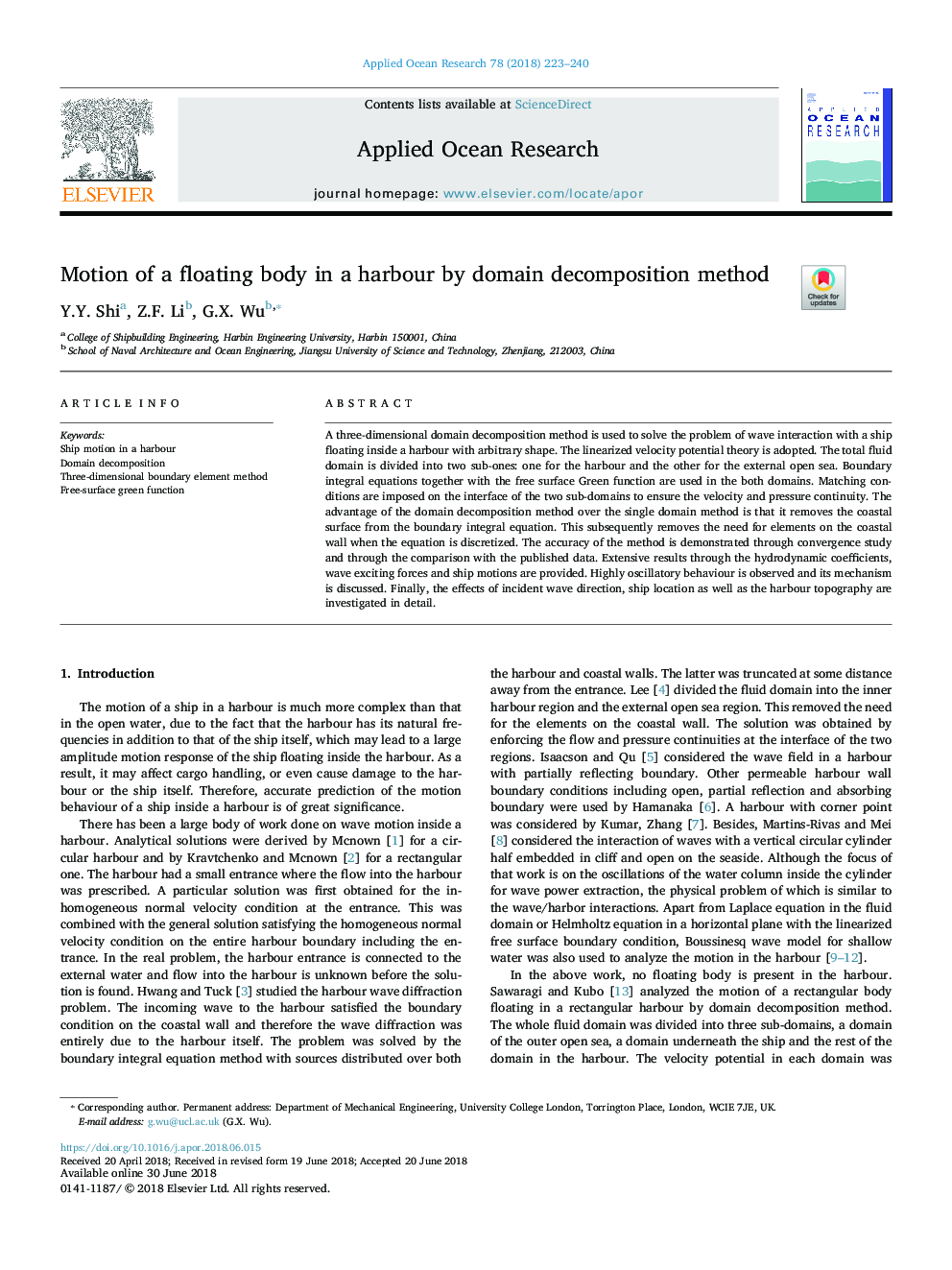| کد مقاله | کد نشریه | سال انتشار | مقاله انگلیسی | نسخه تمام متن |
|---|---|---|---|---|
| 8059217 | 1520225 | 2018 | 18 صفحه PDF | دانلود رایگان |
عنوان انگلیسی مقاله ISI
Motion of a floating body in a harbour by domain decomposition method
ترجمه فارسی عنوان
حرکت یک جسم شناور در بندر به وسیله روش تجزیه دامنه
دانلود مقاله + سفارش ترجمه
دانلود مقاله ISI انگلیسی
رایگان برای ایرانیان
کلمات کلیدی
حرکت کشتی در بندر، تجزیه دامنه، روش عنصر مرزی سه بعدی، عملکرد سطح سبز آزاد،
ترجمه چکیده
یک روش تجزیه دامنه سه بعدی برای حل مشکل تعامل موج با کشتی شناور در داخل بندر با شکل دلخواه مورد استفاده قرار می گیرد. نظریه پتانسیل سرعت خطی پذیرفته شده است. دامنه مایع کل به دو زیرین تقسیم می شود: یکی برای بندر و دیگری برای دریای بیرونی خارجی. معادلات انتگرال مرزی با سطح آزاد سطح عملکرد سبز در هر دو حوزه استفاده می شود. شرایط تطبیقی بر روی رابط دو زیر دامنه اعمال می شود تا تداوم سرعت و فشار را تضمین کند. مزیت روش تجزیه دامنه در روش تک دامنه این است که سطح ساحلی را از معادله انتگرال مرزی حذف می کند. این بعد نیاز به عناصر در دیوار ساحلی را هنگامی که معادله غیرقابل تشخیص است حذف می کند. دقت روش از طریق روش همگرا و از طریق مقایسه با داده های منتشر شده نشان داده شده است. نتایج گسترده ای از طریق ضرایب هیدرودینامیکی، نیروهای موج هیجان انگیز و حرکت کشتی ارائه شده است. رفتار بسیار نوسانی مشاهده شده است و مکانیزم آن بحث شده است. در نهایت، اثرات مسیر موج حادثه، موقعیت کشتی و نیز توپوگرافی بندر به طور دقیق مورد بررسی قرار می گیرد.
موضوعات مرتبط
مهندسی و علوم پایه
سایر رشته های مهندسی
مهندسی دریا (اقیانوس)
چکیده انگلیسی
A three-dimensional domain decomposition method is used to solve the problem of wave interaction with a ship floating inside a harbour with arbitrary shape. The linearized velocity potential theory is adopted. The total fluid domain is divided into two sub-ones: one for the harbour and the other for the external open sea. Boundary integral equations together with the free surface Green function are used in the both domains. Matching conditions are imposed on the interface of the two sub-domains to ensure the velocity and pressure continuity. The advantage of the domain decomposition method over the single domain method is that it removes the coastal surface from the boundary integral equation. This subsequently removes the need for elements on the coastal wall when the equation is discretized. The accuracy of the method is demonstrated through convergence study and through the comparison with the published data. Extensive results through the hydrodynamic coefficients, wave exciting forces and ship motions are provided. Highly oscillatory behaviour is observed and its mechanism is discussed. Finally, the effects of incident wave direction, ship location as well as the harbour topography are investigated in detail.
ناشر
Database: Elsevier - ScienceDirect (ساینس دایرکت)
Journal: Applied Ocean Research - Volume 78, September 2018, Pages 223-240
Journal: Applied Ocean Research - Volume 78, September 2018, Pages 223-240
نویسندگان
Y.Y. Shi, Z.F. Li, G.X. Wu,
